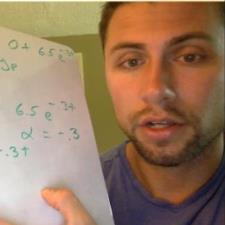
Christopher F. answered • 04/06/20
M.S. in Mathematics with 500+ hours in Calculus tutoring
Green's Theorem turns a line integral into a double integral. It helps simplify hard line integrals into easier double integral problems.
First, with our given field F, we have:
∫F•dr = ∫(-3y)dx + (3x)dy
Green's Theorem says: ∫Mdx + Ndy (over curve C) = ∫∫∂N/∂x - ∂M/∂y dA (over region R)
Our M is -3y and our N is 3x
The partial derivative of M with respect to y (aka ∂M/∂y) is -3
The partial derivative of N with respect to x (aka ∂N/∂x) is 3
Applying Green's to our line integral above, we get: ∫(-3y)dx + (3x)dy = ∫∫3-(-3) dA = ∫∫6dA
∫∫6dA is over region R: x2 + y2 ≤ a2 which is the disk at the origin with radius a
∫∫6dA = 6 ∫∫dA where ∫∫dA is the area of region A, i.e., the disk at the origin with radius a
Area of the disk at the origin with radius a is π a2
So we have ∫(-3y)dx + (3x)dy = ∫∫3-(-3) dA = ∫∫6dA = 6 ∫∫dA = 6*π a2
Had we done the line integral directly:
x= a*cost
y=a*sint
dx= a*(-sint)dt
dy= a*(cost)dt
Then by substitution, ∫(-3y)dx + (3x)dy = ∫ (-3a*sint)*a*(-sint)dt + (3*a*cost)*a*(cost)dt =∫
∫(3a2sin2t)dt + (3a2cos2t)dt = ∫3a2(sin2t+cos2t)dt
But sin2t+cos2t = 1, so we get ∫3a2(sin2t+cos2t)dt = ∫3a2dt (over the curve C: 0≤ t ≤ 2π)
= 3a2 ∫dt (0 to 2π) = 3a2(2π - 0) = 6*π a2
Our Line integral and Double Integral match; they both equal 6*π a2. This verify's green's theorem by evaluating both sides of the equation for the given field F.
Hope this helps! If you have any questions about the steps, please comment. :)




